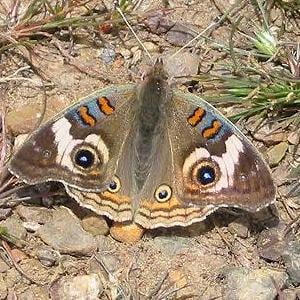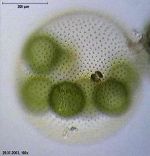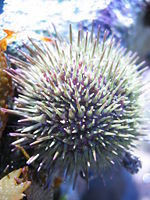Difference between revisions of "Symmetry (biology)" - New World Encyclopedia
m ({{Contracted}}) |
Rick Swarts (talk | contribs) |
||
| Line 2: | Line 2: | ||
[[Image:Commonbuckeye.JPG|thumb|The elaborate patterns on the wings of [[butterfly|butterflies]] are one example of bilateral symmetry.]] | [[Image:Commonbuckeye.JPG|thumb|The elaborate patterns on the wings of [[butterfly|butterflies]] are one example of bilateral symmetry.]] | ||
| − | '''Symmetry in biology''' is the balanced | + | '''Symmetry in biology''' is the balanced arrangement of body parts or shapes around a central point or axis. That is, the size, shape, and relative location on one side of a dividing line mirrors the size, shape, and relative location on the other side. |
| − | In [[ | + | In nature, there are three basic kinds of symmetry: [[#Spherical symmetry|spherical]], [[#Radial symmetry|radial]], or [[#Bilaterial symmetry|bilaterial]]. The body plans of most multicellular organisms exhibit one of these forms. A small minority exhibit no symmetry (are ''asymmetric''). |
| − | == | + | In [[biology]], symmetry is approximate. For example, [[plant]] [[leaf|leaves]], while considered symmetric, will rarely match up exactly when folded in half. Furthermore, symmetry may refer only to the external form and not the internal anatomy. |
| + | |||
| + | ==Spherical symmetry== | ||
| + | [[Image:Volvox_aureus.jpg|thumb|right|150px|''Volvox aureus''.]] | ||
| + | In spherical symmetry, '''any plane''' that passes through the the center of the object divides the form into two identical halves that are mirror images of each other. Such objects are shaped like spheres or globes. For example, a round ball exhibits spherical symmetry at some point in their lives. (The sea cucumber, an echinoderm, exhibits bilaterial symmetry as an adult.) | ||
| + | In nature, spherican symmetry is exhibited by the external form of many colonial algae, such as ''Volvox''. | ||
| + | ==Radial symmetry== | ||
| + | In radial symmetry, '''all planes passing through a central axis''' (normally vertical) divides the form into two identical halves that are mirror images of each other. Such a form will have distinct ends (usually top and bottom) and any plane that passes through its longitudinal axis (a line from end to end through the center) will create two similar halves (Towle 1989). | ||
| − | These organisms resembles a pie where several cutting | + | These organisms resembles a pie where several cutting planes produce roughly identical pieces. An organism with radial symmetry exhibits no left or right sides. They have a top and a bottom surface only. |
| − | + | '''Animals with radial symmetry'''. Most radially symmetric animals are symmetrical about an axis extending from the center of the oral surface, which contains the mouth, to the center of the opposite, or aboral, end. This type of symmetry is especially suitable for sessile animals such as the [[sea anemone]], floating animals such as [[jellyfish]], and slow moving organisms such as [[sea star]]s (see special forms of radial symmetry). Animals in the phyla [[cnidaria]] and [[echinoderm|echinodermata]] exhibit radial symmetry. | |
| − | Most radially symmetric animals are symmetrical about an axis extending from the center of the oral surface, which contains the mouth, to the center of the opposite, or aboral, end. This type of symmetry is especially suitable for | ||
| − | + | '''Plants with radial symmetry'''. Many [[flower]]s, such as buttercups and daffodils, are radially symmetric (also known as actinomorphic). Roughly identical petals, sepals, and stamen occur at regular intervals around the center of the flower. | |
| − | Many [[flower]]s, such as | ||
| Line 24: | Line 29: | ||
====Pentamerism==== | ====Pentamerism==== | ||
| + | [[Image:SeaUrchin.jpg|thumb|left|150px|A sea urchin.]] | ||
| + | Like other echinoderms they have five-fold symmetry (called pentamerism) and move by means of hundreds of tiny, transparent, adhesive "tube feet". The pentamerous symmetry is not obvious at a casual glance, but is easily seen in the dried shell of the urchin (see picture below, right). | ||
This variant of radial symmetry (also called pentaradial and pentagonal symmetry) arranges roughly equal parts around a central axis at orientations of 72° apart. | This variant of radial symmetry (also called pentaradial and pentagonal symmetry) arranges roughly equal parts around a central axis at orientations of 72° apart. | ||
Revision as of 22:50, 9 December 2006

Symmetry in biology is the balanced arrangement of body parts or shapes around a central point or axis. That is, the size, shape, and relative location on one side of a dividing line mirrors the size, shape, and relative location on the other side.
In nature, there are three basic kinds of symmetry: spherical, radial, or bilaterial. The body plans of most multicellular organisms exhibit one of these forms. A small minority exhibit no symmetry (are asymmetric).
In biology, symmetry is approximate. For example, plant leaves, while considered symmetric, will rarely match up exactly when folded in half. Furthermore, symmetry may refer only to the external form and not the internal anatomy.
Spherical symmetry
In spherical symmetry, any plane that passes through the the center of the object divides the form into two identical halves that are mirror images of each other. Such objects are shaped like spheres or globes. For example, a round ball exhibits spherical symmetry at some point in their lives. (The sea cucumber, an echinoderm, exhibits bilaterial symmetry as an adult.)
In nature, spherican symmetry is exhibited by the external form of many colonial algae, such as Volvox.
Radial symmetry
In radial symmetry, all planes passing through a central axis (normally vertical) divides the form into two identical halves that are mirror images of each other. Such a form will have distinct ends (usually top and bottom) and any plane that passes through its longitudinal axis (a line from end to end through the center) will create two similar halves (Towle 1989).
These organisms resembles a pie where several cutting planes produce roughly identical pieces. An organism with radial symmetry exhibits no left or right sides. They have a top and a bottom surface only.
Animals with radial symmetry. Most radially symmetric animals are symmetrical about an axis extending from the center of the oral surface, which contains the mouth, to the center of the opposite, or aboral, end. This type of symmetry is especially suitable for sessile animals such as the sea anemone, floating animals such as jellyfish, and slow moving organisms such as sea stars (see special forms of radial symmetry). Animals in the phyla cnidaria and echinodermata exhibit radial symmetry.
Plants with radial symmetry. Many flowers, such as buttercups and daffodils, are radially symmetric (also known as actinomorphic). Roughly identical petals, sepals, and stamen occur at regular intervals around the center of the flower.
Special forms of radial symmetry
Tetramerism
Many jellyfish have four radial canals and thus exhibit tetramerous radial symmetry
Pentamerism
Like other echinoderms they have five-fold symmetry (called pentamerism) and move by means of hundreds of tiny, transparent, adhesive "tube feet". The pentamerous symmetry is not obvious at a casual glance, but is easily seen in the dried shell of the urchin (see picture below, right). This variant of radial symmetry (also called pentaradial and pentagonal symmetry) arranges roughly equal parts around a central axis at orientations of 72° apart.
- Animals
Members of the phyla echinodermata (like starfish) arrange parts around the axis of theforms. Examples include the Pentaspheridae, the Pentinastrum group of general in the Euchitoniidae, and Cicorrhegma (Circoporidae).
- Plants
Flowering plants demonstrate symmetry of five more frequently than any other form.
Around 1510–1516 C.E., Leonardo da Vinci determined that in many plants a sixth leaf stands above the first. This arrangement later became known as 2/5 phyllotaxy, a system where repetitions of five leaves occur in two turns of the axis. This is the most common of all patterns of leaf arrangement.
Bilateral symmetry
In bilateral symmetry (also called plane symmetry), only one plane, called the sagittal plane, will divide an organism into roughly mirror image halves (with respect to external appearance only). Thus there is approximate reflection symmetry. Often the two halves can meaningfully be referred to as the right and left halves, e.g. in the case of an animal with a main direction of motion in the plane of symmetry.
Animals
Most animals are bilaterally symmetric, including humans (see also facial symmetry), and belong to the group Bilateria. The oldest known bilateral animal is the Vernanimalcula.
Bilateral symmetry permits streamlining, favors the formation of a central nerve center, contributes to cephalization, and promotes actively moving organisms. Bilateral symmetry is an aspect of both chordates and vertebrates.
Plants
Flowers such as orchids and sweet peas are bilaterally symmetrical (also known as zygomorphic). The leaves of most plants are also bilaterally symmetrical.
Asymmetry
The notable exception among animals are the Porifera (sponges) which have no symmetry.
See also
- Floral symmetry
- Supernumerary body part
ReferencesISBN links support NWE through referral fees
- Fact Monster
- Heads, Michael. "Principia Botanica: Croizat's Contribution to Botany." Tuatara 27.1 (1984): 26-48.
- Zoology a website by the Monaco educational service
External links
- Live Science.com article called "Symmetry in Nature: Fundamental Fact or Human Bias?" By Ker Than
Credits
New World Encyclopedia writers and editors rewrote and completed the Wikipedia article in accordance with New World Encyclopedia standards. This article abides by terms of the Creative Commons CC-by-sa 3.0 License (CC-by-sa), which may be used and disseminated with proper attribution. Credit is due under the terms of this license that can reference both the New World Encyclopedia contributors and the selfless volunteer contributors of the Wikimedia Foundation. To cite this article click here for a list of acceptable citing formats.The history of earlier contributions by wikipedians is accessible to researchers here:
The history of this article since it was imported to New World Encyclopedia:
Note: Some restrictions may apply to use of individual images which are separately licensed.

